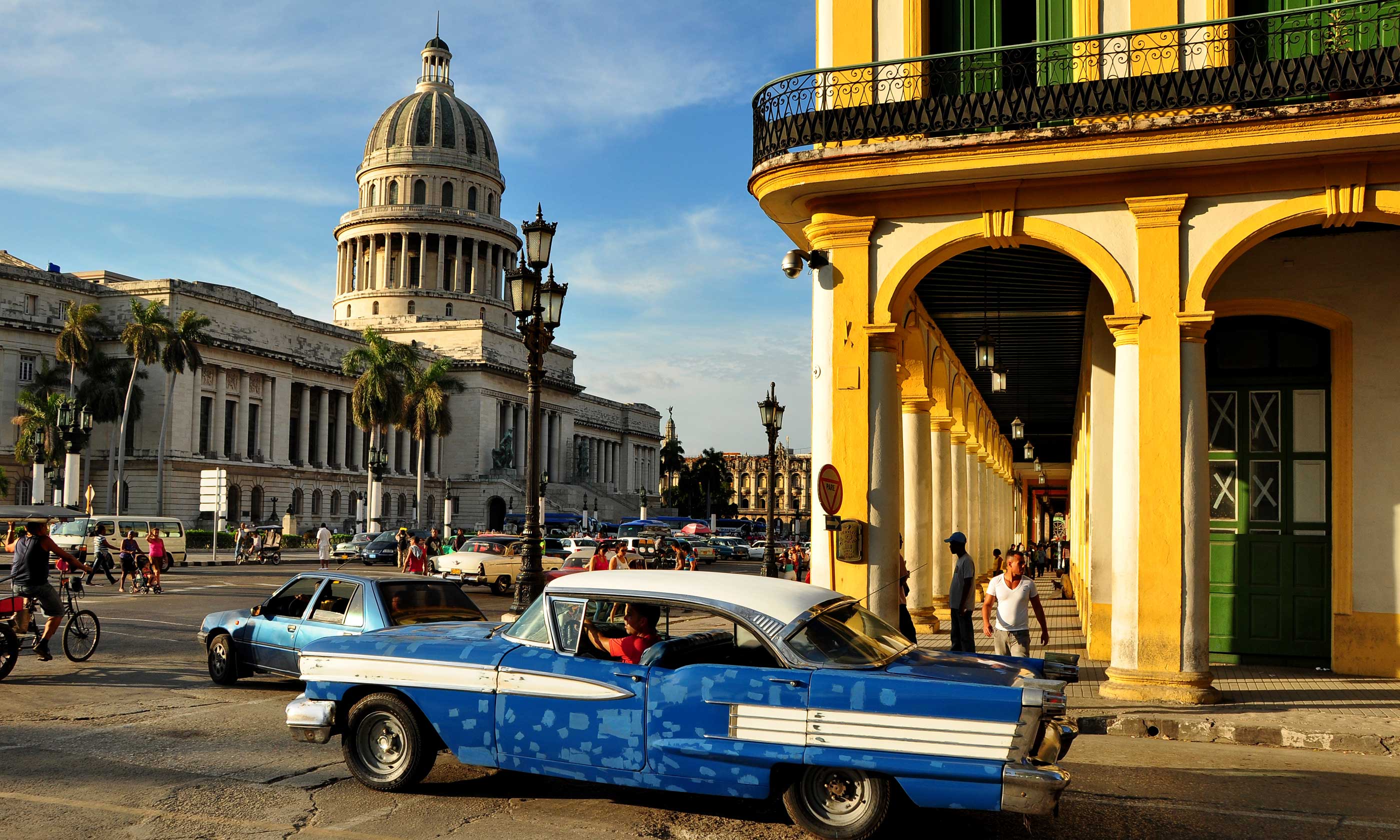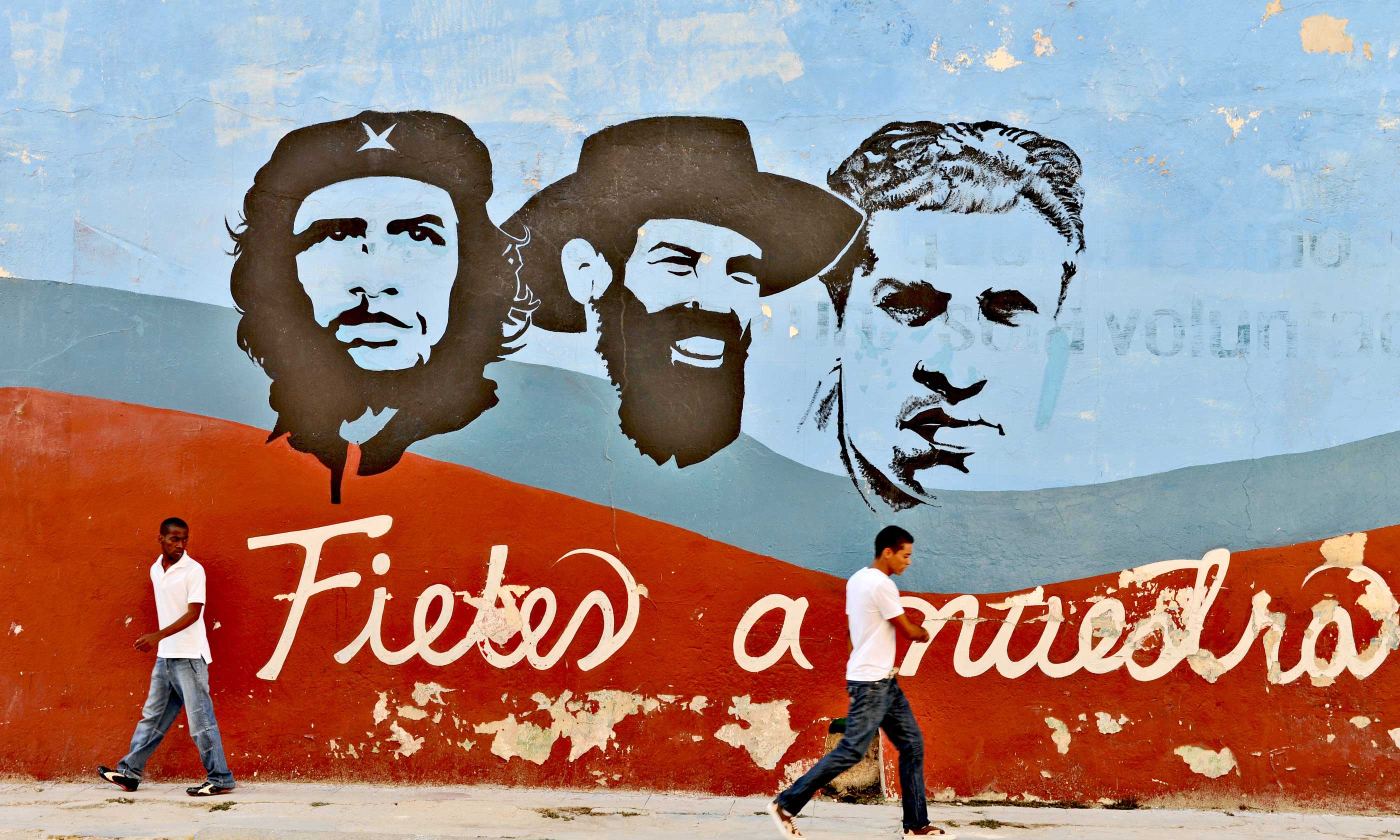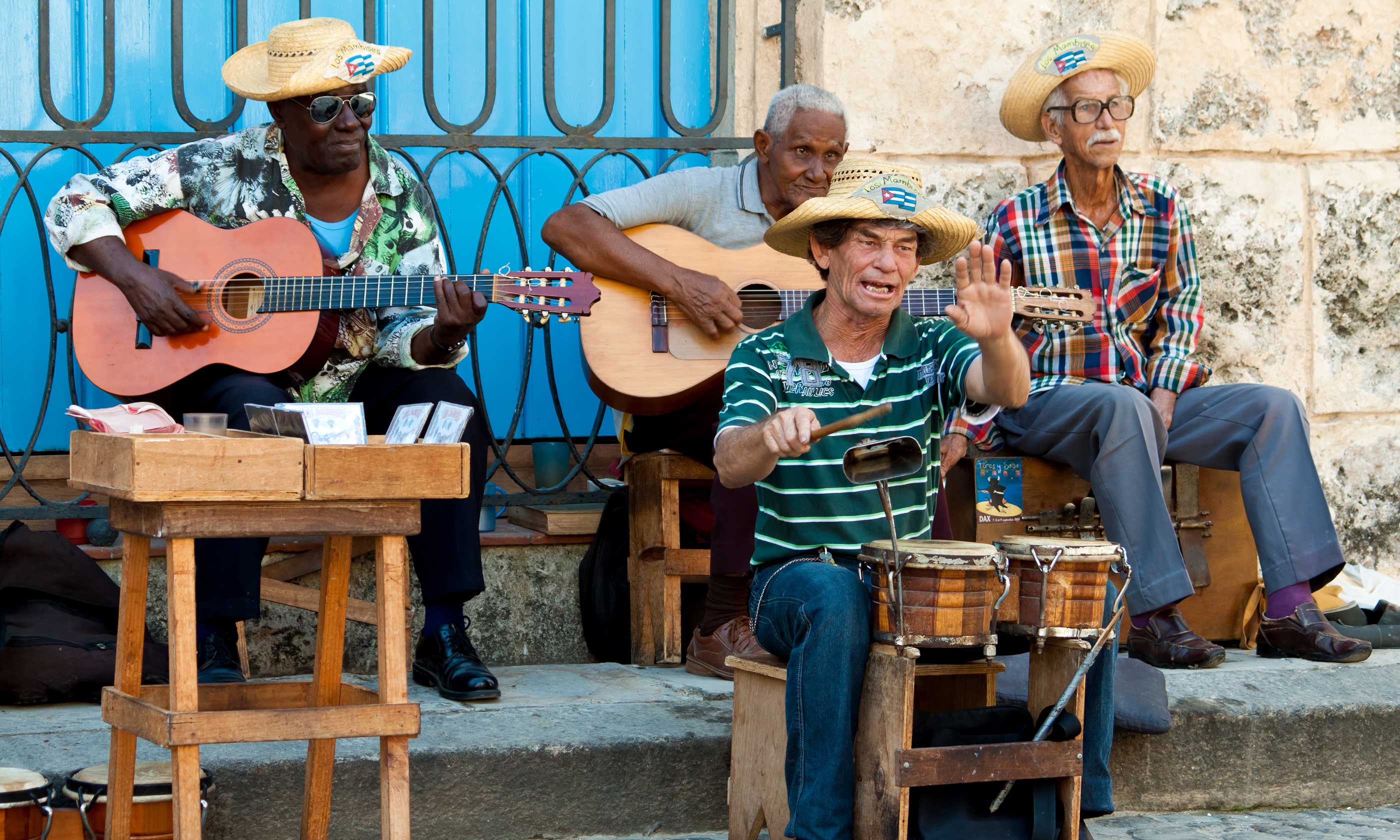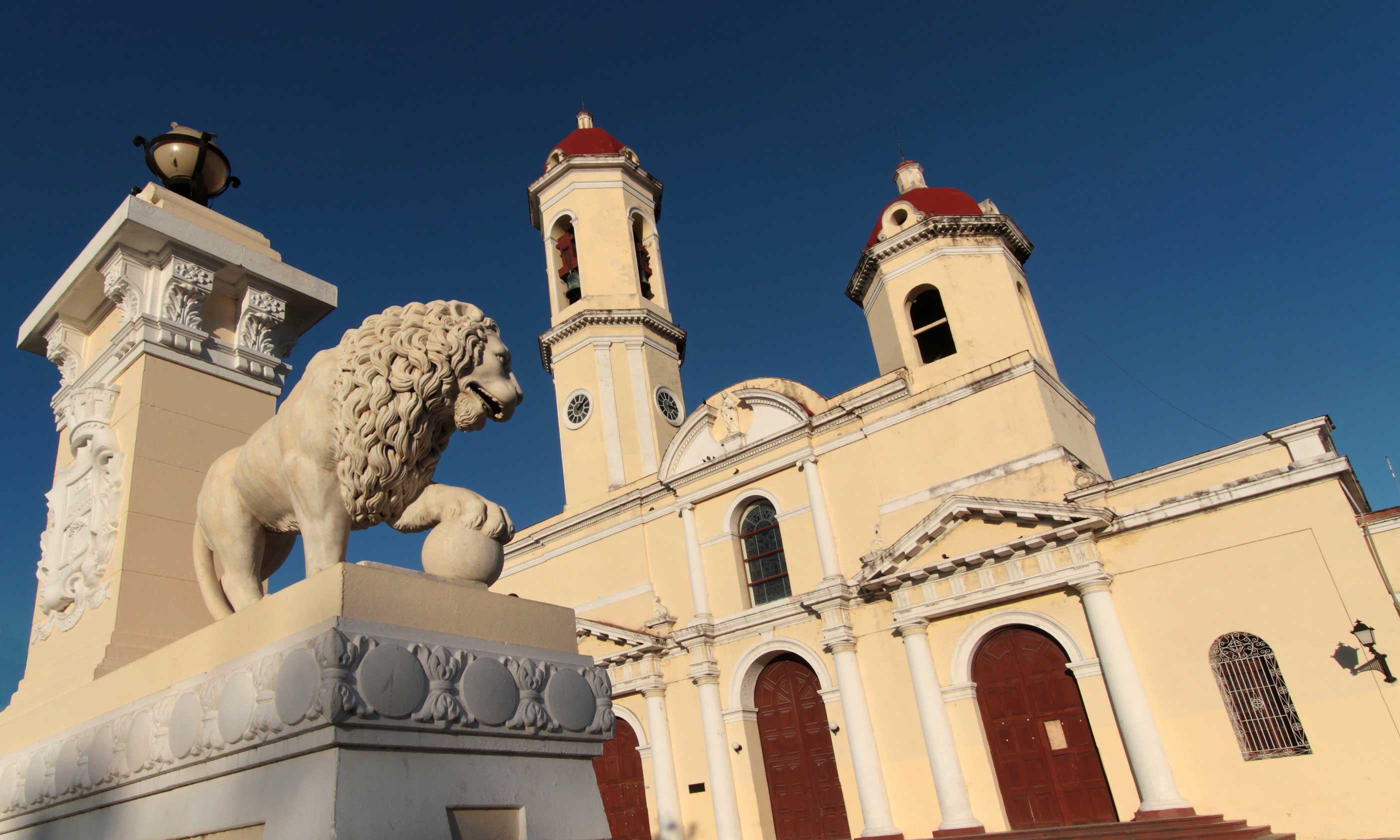
Cuba is on the verge of monumental change – but what do the locals make of it? Stay in the island’s network of homestays to find out
The house was the kind you imagine in your Latin American dreams: high ceilings, dark wood furniture, family insignia frosted on the windows, morning sun streaming through white lace curtains.
Tropical fish mooched around an aquarium, tropical birds twittered in an antique cage. Coffee bubbled on the hob. And there was art everywhere. José Toirac is one of Cuba’s most respected artists but, because gallery spaces are rare and expensive, if you want to see his drawings, paintings and installations, you have to visit his house.
I took in a painting he’d made of a dead Che Guevara. The cadaver was covered in tallies adding up to 638, the reported – but unverifiable – number of attempts on Fidel Castro’s life to date. Another work showed Che’s profile in gold lead, an allusion to his putative sainthood.
I’d already had an eyeful of Ernesto – the posters, the souvenirs and the tribute on Havana’s Plaza de la Revolución – but Toirac’s art deconstructed all the hagiography and summoned a contemporary spirit into the nostalgia-laden house.
After talking me through his works, José – because we were now on first-name terms – poured me a coffee and chatted to me about the USSR and pop art, politics and travel. There’s nothing like being at home to make people relax and open up.
In Cuba, where the gap between the official version of life and the reality of ordinary citizens is immense, sharing someone’s private space is like peeking behind a veil, sharing a secret.
I was in Cuba in the spring after President Obama announced his plan to reestablish diplomatic relations between Washington DC and Havana, after a half-century of mutual – and sometimes belligerent – mistrust.
Tourism was booming, the result of the desperate dash to experience Cuba before it’s overwhelmed by tourists from its big capitalist neighbour or – worse – significantly changed as a result of this new development. It also meant all the hotels were booked.
As a virtuous consequence, I was spending a week staying only in private houses – or casas particulares – a nice way for residents to make a little extra money. This would provide me with a close-up of a country on the cusp of… something.
My home from home on Calle Línea, a busy thoroughfare in Havana’s Vedado district, was another stately affair. It had a long, dark hallway and a patio at the back bursting with tropical plants, the walls painted in distressed lemon and peach.
Here I breakfasted on papaya and toast, and freshly brewed coffee. After my second cup, I went down the corridor to collect my passport – Cuba’s one of those bureaucratic countries where you have be registered with ‘the authorities’ every day – and bumped into the proprietor.

The Visual Explorer / Shutterstock.com
“Buenos días,” he said. “I’m Don Cecilio Martínez – everyone calls me Chilo.” I asked how things were going with the easing of tensions with the US. “We’ve had four or five revolutions,” he barked, “but the only one anyone knows about is the 1959 one. Yes, we need the changes – we need technology, transport, tourism. We could be a very rich country. It’s not easy, you know, having a country like that on your doorstep.”
He spat this out, and then went on to damn Blair and Bush. He talked about Obama’s Janus-like behaviour: “There must be two Obamas – the one that everyone sees, and the real one who is sincere and good.”
He talked for ten minutes without taking a breath. Chilo said he was in his late 70s and had seen it all. I commented on his good health and how he must have looked after himself. “I smoke two packets of cigarettes a day,” he said, pulling out a fag and lighting it. “I have a glass of rum whenever I want one, and I enjoy a cigar.”
The dirty perfume of the latter drifted around the corridors of Chilo’s house. There was something decadent about the place, as there was about his politics: the revolution was “necessary”, and yet here was one of the old guard renting out a room on the open market to a tourist. With the temperature rising on my patio and the humidity beginning to impose its languorous weight on everything, I decided to go out and explore.
I spent a couple of days exploring Havana. I walked everywhere, following the Malecón – the curving esplanade that follows the seawall – all the way into the old town. Many of the grandest buildings, especially the seafront mansions of Centro Habana, had been damaged beyond repair by the salty spray.

Kamira / Shutterstock.com;
Refurbishment works are visible across the city, though. La Habana Vieja – the historic centre, where most of the hotels and tourism is focused – is littered with scaffolding. New bars and restaurants are opening all the time, hotels are being modernised, and the streets are full of new cars as well as the vintage Pontiacs and De Sotos. There’s definitely a sense that change is in the air.
I spent a morning admiring the Cuban art section of the Museo Nacional de Bellas Artes. The large, well-lit modern gallery of colonial-era, modern and contemporary works helped me make connections between the country’s bourgeois past and the Communist present – and all those revolutions that Don Camilo had insisted I needed to know about.
Casa Camilo was convenient, but Línea was full of bars and clubs– and all-night salsa. On a Saturday morning I moved out to Casa Belkis, in a residential part of Vedado, close to the huge Colón necropolis.
Here I had an entire apartment to myself, with a kitchen and living room – all for £20 a night. I wandered around the cemetery’s monumental avenues – messy death turned into cold marble and ornamental ostentation – and then along a busy avenue, full of cafés that ordinary Cubans frequent on their days off.
Alessandro was the owner of a newly opened pizzeria; as he served me a delicious and dirt-cheap pizza, he told me he had married a Cuban in Italy and migrated to Havana.
The island is more famous for exporting exiles and desperate escapists, so I asked Alessandro if his situation was becoming more common. “I’ve met a few,” he said. “The European situation is terrible. It’s much better here.”
You could have a great Cuban adventure visiting houses in Havana and dining out, but capital cities rarely reflect national attitudes. I hired a car – sadly, only a modern Isuzu – for the highway trip and, with my driver Felipe, headed east.
I wanted to see farmland and wilderness, the uncluttered beaches of the Caribbean coast, the beautiful provincial cities of central Cuba and the people who reside in them.
Once I left Havana’s suburbs, the side of the almost traffic-free highway was taken over by crops of pineapple and banana, maize and mango. Hoardings paid homage to Fidel, Che, Hugo Chávez and Henry Reeve, an American who fought in the pro-Independence Liberation Army against the Spanish at the end of the 19th century.
After a couple of hours we turned on to a back road through the vast swamplands of the Cienaga de Zapata, where palm trees and tall reeds provided a habitat for herons, buzzards and egrets.
The 60-something Felipe regaled me with stories about the revolution, baseball, fighting in Africa, women, sex and music. He’d been a radio soap-opera writer in a previous life and had been around the island, and the block, many times.
The swamp meets the sea at the Bay of Pigs. In the town of Playa Girón was a museum dedicated to the 1961 invasion by CIA-sponsored paramilitary forces. Shunning any kind of objectivity, the machine guns, uniforms, photographs and news reports were captioned with anti-American propaganda. The ‘Imperialist Cowards’ had been ‘Heroically Resisted’ by the ‘Faithful Followers of Fidel’.
Further east, in Cienfuegos, I stayed with husband and wife Ricardo Peña and Hortensia Vizarino. Before I went off to explore the city, we had coffee and cake, and Ricardo showed me his beloved 1950s Austin A30 – where, during the following two days, he spent every spare minute bent double in the tiny passenger seat trying to untangle a complex knot of ancient wiring.
Cienfuegos was founded in 1819, making it one of Cuba’s oldest cities – its colonial centre is a neat and tidy UNESCO-listed assembly of handsome apartment blocks, pastel-painted facades and lively ice-cream parlours, bars, restaurants and shops.
At the town’s southern end was Punta Gorda, a slender peninsula where I popped into the wedding-cake building that used to house the Yacht Club; old photographs showed the smiling faces of the well-heeled crowd pre-1959.
One of the faces belonged to Osvaldo Dorticós Torrado, unknown to me. He was, in fact, president of Cuba from 1959 to 1973 and had spent his pre-revolution days, like Fidel Castro – prime minister during those years – very much a member of the Cuban upper-classes.
When I got home that evening, Hortensia was talking on the telephone for a long time. When she hung up she looked worried. “I was chatting to my mother. She lives in Alabama. She came to visit two years ago but I don’t think she’ll be coming again. She’s 94 and we just daren’t risk her falling ill here.”
The warming up of the relationship between Washington DCand Havana is too late for her mother, but Hortensia remains upbeat. “We can’t carry on being enemies like this,” she said, “we are too close to one another.”
An hour’s drive west of Cienfuegos is the prettiest of all Cuba’s colonial treasures. Trinidad, founded in 1514, is all low-slung adobe buildings and streets paved in stones that seem to tumble down the hill on which the city was sited.
Its remarkable state of preservation is partly due to the fact that the hinterland was never really allowed to evolve – it’s often overlooked that Cuba remained Spanish until 1898, and was, with Puerto Rico, Spain’s last colonial outpost in the West Indies.

Lion and church of Cienfuegos, Shutterstock
My homestay was not one of the pricey old places in the centre but a modern, hostel-like building on the edge of the city. If it lacked character, it made up for it with panoramic views over Trinidad and cool breezes on the balcony where I breakfasted each morning.
Afterwards I wandered around the churches and mansions and found a bench on the immaculately maintained plaza. The only passing traffic was a few cowboys on horseback and the occasional bust-up old car, the four-wheeled vehicles always moving more slowly and awkwardly over the rough cobbles than the four-legged ones.
Felipe took me to dine at a hotel on the coast, where I saw package tourists from Sweden and Germany being offloaded from coaches. The disembarked were corralled into queues to eat at the buffet, doomed to chat only to themselves. They probably had better air-con than me, but not much else.
I made a day trip to Sancti Spíritus, a less picturesque conurbation, best known for the handsome 1815 Yayabo Bridge, built from clay bricks. I skipped the Museum of the Guayabera – one Cuban shirt looks much like any other – and hung out with Felipe instead.
He showed me the grocery-cum-electronics-cum-beer stores where Cubans use their own currency – the CUP (nation peso) – instead of the CUC (convertible peso).
On the way back to Havana, we stopped off in Santa Clara. As we entered the city, I pulled my sunglasses down to protect my eyes from the glare of the midday sun and from the probable exposure of a thousand Che Guevaras. This was his burial site – his column liberated the small city in December 1958 in the revolution’s decisive battle – and there was bound to be a rush of iconography.
But as it turned out, Santa Clara had the usual count of murals and motifs, with the shops selling plaques of the beret-wearing, cigar-puffing Argentine legend alongside garish paintings of old American cars, salsa musicians and other tack. My mind flashed back to Toirac, whose work decoded – and quietly satirised – commie kitsch.
I strolled around the main plaza, Parque Vidal, surveying the palm trees, the old gazebo, the handsome Teatro La Caridad, built in 1885. But my gaze was drawn, inevitably, to the pig-ugly Hotel Santa Clara Libre on the plaza’s western edge – a classic piece of low-grade Latin American brutalism stapled to an otherwise convivial public space.
The hotel used to be a Hilton, but that brand was ejected from the country shortly after the revolution; fittingly, the hospital-green façade was pocked by machine-gun fire dating from the 1958 battle.
On the edge of the city, the Che Guevara mausoleum was grandiose but not at all garish. The burial chamber was peaceful while the impressive reliefs showed the guerrilla hero’s march from west to east, and from lad to legend.
Coming back to Havana felt a bit like coming home. For a change I’d booked myself the Ambos Mundos for my last night, a near-legendary hotel due to the fact that room 511 was once occupied by that famous daiquiri-drinker Ernest Hemingway.
The reception was stylish, the bar classy and the old cage-style lift – manned by a grumpy and officious attendant – was very 1930s. The room was small but handsome in an old-fashioned way.
But, almost comically, there was no running water in my bathroom – with all the refurbishment taking place, it seemed some hapless builder had driven a pile into the water mains.
Few countries present barriers to comprehension like Cuba. The curvaceous cars, the sultry salsa, the tobacco-scented romanticism all collude to spin a pre-revolutionary fantasy. The military monuments, Skodas and propagandist hoardings work together to create a post-1959 one. Factor in Western prejudices and all your own baggage and a visit is ripe to lead to confusion.
Much of the pleasure to be had in this beguiling island nation derives from this, but a homestay experiences goes some way to cutting through the clichés and contradictions. At the same time, it takes you into the heart of a family, and of ordinary, everyday life.
Everything is changing in Cuba; if you want to witness that, discuss it, and live a bit of it, then sleep in a casa – and you’ll open your eyes to a new perspective on the country every day.
The author travelled with Audley Travel, which can arrange a ten-day trip to Cuba, covering Havana, Cienfuegos and Trinidad, from £2,395pp, including three-star accommodation, international flights and guides.
Getting there
Virgin Atlantic flies London Gatwick-Havana non-stop. Economy returns start from £855; flight time from 9.5 hours.
Getting around
Viazul operates buses connecting Havana to the main cities. Havana-Cienfuegos takes around five hours; fares US$20 one-way. A slow, infrequent, inexpensive rail service connects Havana, Cienfuegos, Santa Clara and Sancti Spíritus.
Car hire is possible. Prices start from around CUC40 (£26) a day. Global firms do not operate in Cuba; see cuba-junky.com for a list of local firms. If you want to hire a driver, too, triple the rate.
Cuba is quite expensive, with the tourist currency designed to keep visitors away from local markets. Meals in small restaurants or paladares (private houses) cost £8-15. Hotels are expensive but homestays start from £10 a night, usually including a simple breakfast. Tips are expected.
Main image caption unmillonedeelefantes / Shutterstock.com